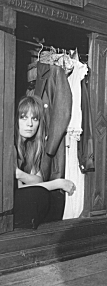|
|
‘Repulsion’
was described by one critic as ‘the most terrifying film ever made,’ and
it remains, along with ‘Psycho’ and ‘Les Diaboliques’, one of the classic
films of psychological suspense. Unlike ‘Psycho’, there is no neat explanation
at the end. Rather, we are left with an enigmatic ‘clue’ to the horrific
terror and repulsion which sex holds for the pretty blonde Belgian girl
Carol Ledoux.
Throughout the film the camera passes, but sometimes pauses, on a family
photograph on the sideboard. When the landlord is waiting in the flat
he idly picks up the photograph and asks where it was taken. “Brussels,”
she says. The very last shot in the film is of the photograph. The camera
seems to enter into it, it fills the screen. There is the contented mother,
the smiling elder sister and the complacent figure of the father. Behind
the mother’s chair stands a little girl with a terrified expression on
her face, her eyes locked onto the figure of the man, her father. The
camera moves forward into the child’s inscrutable expression until it
advances into the pupil of the eye and the screen turns black. The ending
mirrors the credit sequence which opens with a staring eye. The
camera pans back to reveal the face of a beautiful young girl.
Carol
(Catherine Deneuve) and her sister Helen (Yvonne Furneaux) live in a bed-sit
in South Kensington. Her sexual repression gradually unfolds. As she walks
home from the beauty salon she passes a group of workmen, one sweat-stained
man in a vest aims some remarks at her. The girl is withdrawn, introverted.
She is even aloof towards her boyfriend, the nice-looking, well-mannered
Colin (John Fraser), who catches up to her in the street and arranges
a date. She arrives at the flat noticing the happy laughter of young nuns
in the convent next door. Helen is having an affair with Michael (Ian
Hendry), a married man. Carol resents him, or his maleness and is disturbed
to find him shaving in the bathroom.
|

